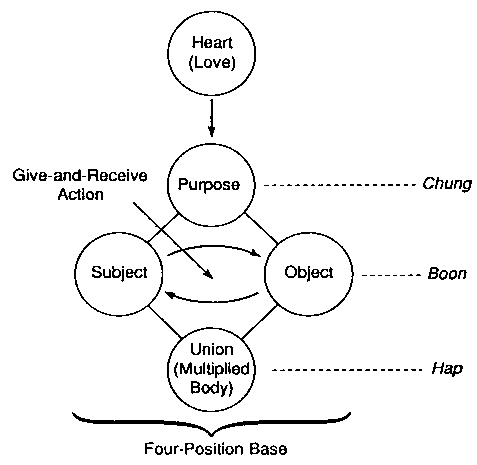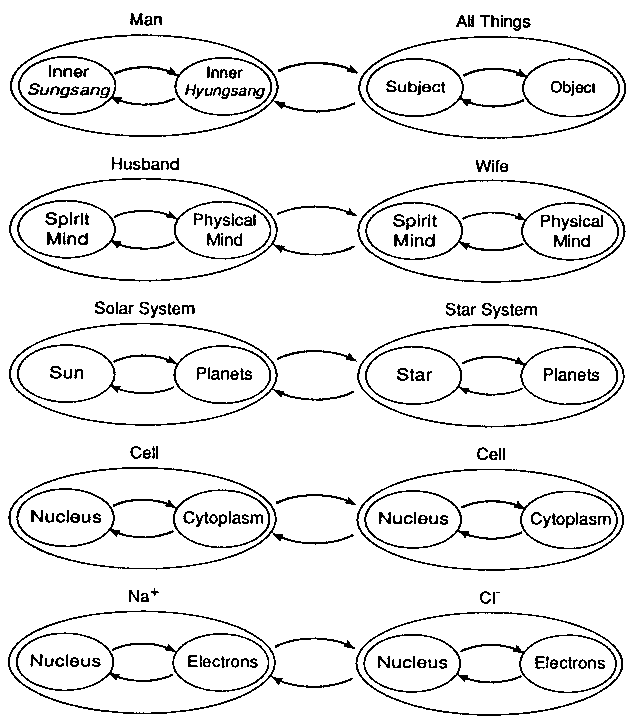II. Unification Methodology - The Give-and-Receive Method
The methodology of Unification Thought is based on the Unification Principle, and is called Unification Methodology. This has also the meaning that it unifies traditional methodologies. The fundamental law of Unification methodology is the "method of give-and-receive action," which is simply called the "give-and-receive method."
A. Kinds of Give-and-Receive Action
Give-and-receive action refers to the interaction between subject and object, and this action has a center, which serves as (lie motive for this action. The nature of give-and-receive action is determined by the nature of the center. When give-and-receive action is carried out centering on Heart, subject and object become united, and the result of the give-and-receive action is a union. When a purpose is set up by Heart, however, arid give-and-receive action takes place centering on that purpose, a multiplied body, or a new-born body, is produced.
The four-position base in the Original Image is a notion dealing with the structure of God's attributes, which is the structure of four positions consisting of Heart (or purpose) as the center, subject, object, and a union (or a multiplied body). Seen from the viewpoint of time, Heart (or purpose), which is the center, exists first; then, with that as the starting point, the subject and the object enter into give-and-receive action; finally, a union or a multiplied body is formed. Here, Heart, which is the center, stands as Origin (Chung); the subject and the object stand as Division (Boon), in the sense that thy are separated and placed face-to-face with each other; and the union or the multiplied body, namely, a result, stands as Union (Hap). The whole process of this give-and receive action is called Origin-Division-Union Action (Chung-Boon-Hap Action) (Fig. 11-2).

Fig. 11-2: Four-Position Base and Chung-Boon-Hap Action
Division, in Origin-Division-Union Action, means not that the Origin is divided into two halves, but that the two elements are separated and placed face-to-face with each other, centering on the Origin.
Boon (Division) in God means the correlative attributes of the one God. Those two correlative attributes enter into give-and-receive action centering on Chung (Origin) and form flap (Union).
There are four kinds of give-and-receive action: identity-maintaining, developmental, inner, and outer give-and-receive actions. Corresponding to these, four kinds of four-position base are formed, namely, identity-maintaining, developmental, inner, and outer four-position bases.
1. Identity-maintaining and Developmental Give-and-Receive Actions
In God, there is the identity-maintaining, unchanging aspect, in which His Sungsang and Hyungsang engage in give-and-receive action centering on Heart, and He exists eternally as a unified being, or a union; also, there is the developmental aspect, in which His Sungsang and Hyungsang engage in give-and-receive action centering on purpose (Purpose of Creation) and produces a multiplied body, or a new-born body, namely, a created being. The first form of give-and-receive action is identity-maintaining give-and-receive action; the second is developmental give-and-receive action. All beings in the created world also perform identity-maintaining and developmental give-and-receive actions, maintaining both unchanging and changing (developing) aspects.
The appearance of the universe is considered to be relatively and generally unchanging. The galaxy constantly maintains the same shape of a convex lens while revolving around the center of the universe. Within it, our solar system revolves around the center of the galaxy in a cycle of 250 million years, but is always located at the same distance from the center of the galaxy. Moreover, the disk shape of the solar system is also unchanging. The solar system has nine planets, each of which maintains its unchanged orbit while revolving around the sun. Each planet maintains its definite characteristics. In this way, the universe has unchanging aspects.
Yet, when seen in terms of the long period of about fifteen billion years, the universe is also found to be developing and growing. Scientists explain this fact by saying that the universe expands, or evolves. The universe has changed from the wholly gaseous state to produce liquids and solids; and on the surface of the earth, plants, animals, and humans have appeared. This process of the universe can be regarded as a kind of process of growth. In this way, the universe has both the aspect of identity-maintenance and the aspect of development.
Living things, as well, develop while maintaining their identity. In plants, seeds sprout, trunks grow, leaves come out, flowers blossom and bear fruit; in this way, they grow constantly. Still, they continue to be the same plants. Particular kinds of plants continue to produce the same kinds of flowers, the same kinds of fruits, etc.
Likewise, animals develop and grow while maintaining their own identity.
The same can be said of human society. In the past, many states appeared, developed, and perished. Yet, the basic pattern of a state, in which sovereign and people are in the relationship of subject and object, remains identical in any state. In a family, family members grow constantly, but the relationships between parents and children, husband and wife, and so on, are unchanging. Individual persons also grow constantly while maintaining their own characteristics as individuals.
In this way, according to the law of give-and-receive, in every being, unchanging characteristics (identity-maintenance) arid changing characteristics (development) are united.
2. Inner and Outer Give-and-receive Actions
Within God's Sungsang (Original Sungsang), the Inner Sungsang and the Inner Hyungsang engage in give-and-receive action centering on Heart, forming a union. Through that, the inner four-position base is formed, which is the internal structure of God's Sungsang. Next, the Original Sungsang and the Original Hyungsang engage in external give-and-receive action, forming a union. At this point, it is the outer four-position base that is formed. When Purpose is established in Heart, the give-and-receive action assumes a dynamic, developmental nature. In the inner four-position base, Logos (conception) is formed as a multiplied body, and in the outer four-position base, created beings are formed as multiplied bodies.
This two-stage structure of inner and outer four-position bases in God is applied without change to the creation. In the relationships between human being and all things (nature), through the inner give-and-receive action human being thinks and establishes conceptions (plans), while at the same time, through the outer give-and-receive action, human being cognizes and has dominion over all things. In human society, if we designate the give-and-receive action between the spirit mind and the physical mind within the human mind as the inner give-and-receive action, then the give-and-receive action between one person and another person (e.g., the give-and-receive action between husband and wife in a family) is the outer give-and-receive action. If we designate the exchanges among family members in a household as inner give-and-receive action, then the exchanges with other people in society become outer give-and-receive action.
Even a state has inner and outer give-and-receive actions. Within a state, the government and the people are engaged in the relationship of subject and object, and thereby politics and economy are carried out. This is inner give-and-receive action. At the same time, political and economic relations are formed with other states; this is outer give-and-receive action.
In the world of nature as well, there are inner and outer give-and-receive actions. In the solar system, inner give-and-receive action takes place between the sun and the planets; at the same time, the solar system is performing outer give-and-receive action with other stars. Also, if we designate the give-and-receive action within the earth the inner give-and-receive action, then the give-and-receive action between the sun and the earth is called outer give-and-receive action. In living things, inner give-and-receive action occurs between the nucleus and the cytoplasm in each cell, while cells perform outer give-and-receive action with one another.
In this way, in the relationships between human being and things, as well as in the relationships in human society and even in the creation, inner and outer give-and-receive actions take place in unity. As these inner and outer give-and-receive actions are carried out smoothly arid harmoniously, things maintain their existence and continue to develop.
Now let us consider the relationship between the deductive and the inductive method on one hand, and the Unification method on the other. Deductive method is the method of logical development through inner give-and-receive action that takes place within the human mind. In contrast, inductive method is the method of examining things in the external world-therefore, it is a method based on outer give-and-receive action. In Unification methodology, inner and outer give-and-receive actions take place in unity. Therefore, in Unification methodology, the inductive and the deductive methods are united.

Fig. 11-3: Example of Inner and Outer Give-and-Receive Actions
B. Scope of the Give-and-Receive Method
As explained above, in the give-and-receive actions there are inner and outer identity-maintaining give-and-receive actions and inner and outer developmental give-and-receive actions. As such, the give-and-receive method is the fundamental method for existence and development in God, human being and nature.
God, while maintaining His eternal nature through inner and outer identity-maintaining give-and-receive actions, created humankind and all things through inner and outer developmental give-and-receive actions.
In humankind and in all things, each individual (individual truth body) maintains its existence and develops as the correlative elements within it perform inner give-and-receive action, and at the same time perform outer give-and-receive action with other individuals.
Give-and-receive action between individuals includes give-and-receive action between a human being and another human being, between human being and things, and between a thing and another thing. First, there is give-and-receive action between one human being and another, which includes individual interaction in family life and in social life. Educational, ethical, political, economic, and other activities are carried out through this type of give-and-receive action.
Next is the give-and-receive action between human being and things. In this type of give-and-receive action, there are two cases, namely, the case in which human being exercises dominion over things, and the case in which human being cognizes things. The cognition of all things includes the basic study of natural sciences, the exploration and appreciation of nature, and so forth. Dominion over things includes applied research in natural sciences, business and economic activities, creative activities in art, and so forth.
Finally, there is the give-and-receive action between a thing and another. In nature, numerous individuals form an organic orderly world as they engage in give-and-receive actions through their respective positions-such as the give-and-receive action among atoms, among cells, and among stars. The interaction between the parts of a machine is another example of this case.
Thinking and conversation are also carried out according to the give-and-receive method. That is to say, when the subjective part in thinking (inner Sungsang), namely, the functions of intellect, emotion, and will, and the objective part (inner Hyungsang), namely, ideas, concepts, laws, mathematical principles, etc., enter into give-and-receive action, human thinking is conducted.
Judgment in thinking is also based on the give-and-receive method. In the judgment, "This flower is a rose," for example, contrast-type give-and-receive action takes place, in which one compares the idea "this flower" with the idea "rose." Conversation, also, follows the give-and-receive method. If one person talks nonsense, the other cannot understand what that person is saying, I can understand what another person is saying because the notions and concepts of that person are in accord with mine, and AM because the laws of thought and laws of conversation of the other person are in accord with mine.
C. Types of Give-and-Receive Actions
The give-and-receive method has the following five types of give-and-receive actions, which were explained in Ontology:
i) Bi-Conscious Type
ii) Uni-Conscious Type
iii) Unconscious Type
iv) Heteronomous Type
v) Contrast-type (Collation Type)
D. Characteristics of the Give-and-Receive Method
The give-and-receive method has the following seven characteristics which also were explained in Ontology:
i) Correlativity
ii) Purposefulness And Centrality
iii) Order and Position
iv) Harmony
v) Individuality and Connectedness
vi) Identity-Maintaining Nature and Developmental Nature
vii) Circular motion